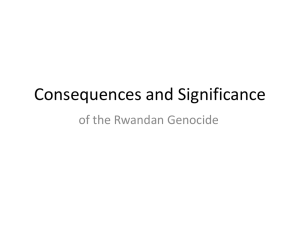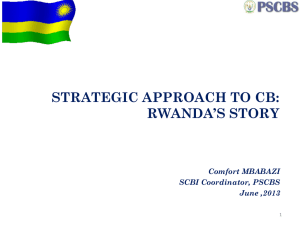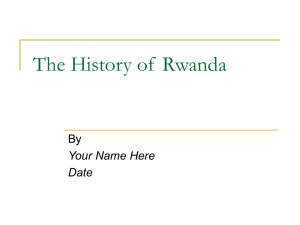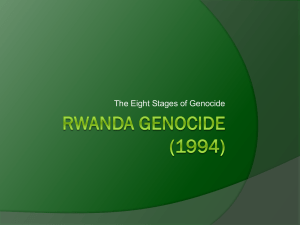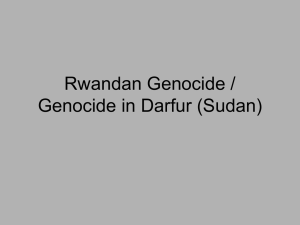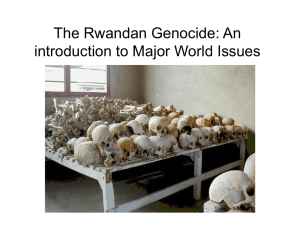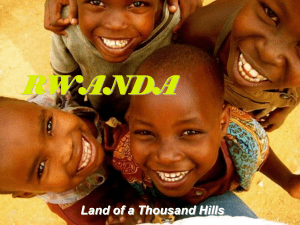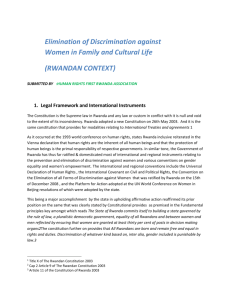Rwanda - Zonta International
advertisement
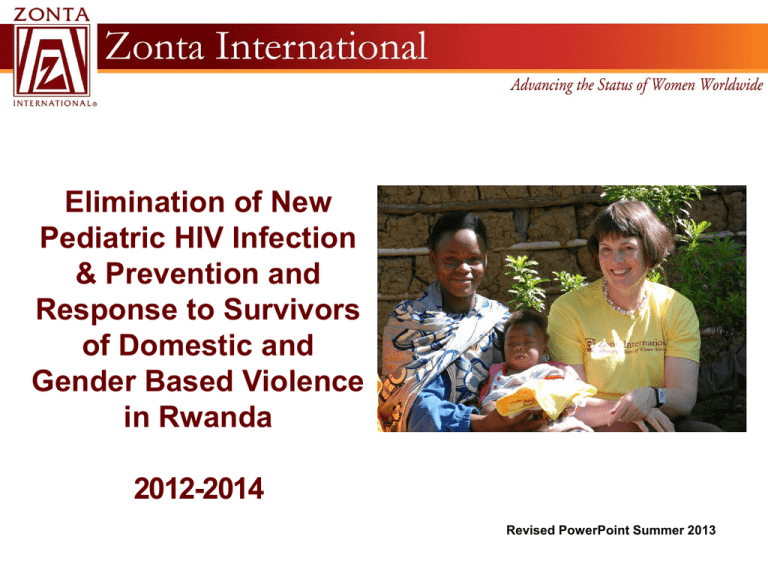
Elimination of New Pediatric HIV Infection & Prevention and Response to Survivors of Domestic and Gender Based Violence in Rwanda 2012-2014 Revised PowerPoint Summer 2013 Rwanda (The Millenium Development Goals Report 2011) Republic in central and eastern Africa Population: 10.5 million (August 2012) Ethnic groups: Hutu 84%, Tutsi 15%, Twa 1% One of the poorest countries in the world GDP per capita (PPP US$): 1,032 Population below $1 (PPP) per day: 76.8% Human Development Index Rank: 166 (1-187, 1 is highest) Rwanda in Statistics (The Millenium Development Goals Report 2011) Seats held by women in Parliament: 56% Female enrollment in primary education: 97% Life expectancy at birth: women 60, men 57 years Maternal mortality ratio: 487 deaths per 100,000 births Infant mortality rate: 70 deaths per 1,000 live births Births attended by skilled health personnel: 52.1% Contraceptive prevalence rate: 36.4% 3% of the population HIV positive 90% infected during pregnancy Children in Rwanda (Unicef 1/2011) Half of the population children (48% 2012) 21% of children under 18 years of age are orphans 60% of Rwandan children live below the poverty line 11% of Rwandan children are involved in child labor One of the world’s highest concentration of orphans Rwanda - History In the early 1990s, Hutu extremists within Rwanda’s political elite blamed the entire Tutsi minority population for the country’s increasing social, economic and political problems. In 1994, the Rwandan genocide exploded after the plane which carried President Habyarimana, a Hutu, was shot down. Under the cover of war, Hutu extremists launched the Rwandan genocide targeting the extinction of the Tutsi people. Rwanda 1994 After the genocide and war, Rwanda has been a country of vulnerable women and children. In 100 days, 500,000 - 1,000,000 Tutsi and politically moderate Hutu were killed. Approximately 400,000 children were orphaned. Women were raped. 50% of health workers were killed or deported. 3,700,000 refugees. After the genocide, Rwanda had critical issues impeding its development: Mother-to-child transmission of HIV/AIDS Gender-based violence Critical issues: Treating HIV positive women Preventing transmission of the virus to their offspring Giving women healthcare and reproductive health services Preventing and responding to the violence stemming from the brutalization of the society In response to these urgent needs Zonta International will provide US$1,000,000 to eliminate new pediatric HIV infections and prevent domestic and gender-based violence in Rwanda in cooperation with the United Nations Children´s Fund (UNICEF). Zonta International’s Support: US$600,000 (2008-2010) US$500,000 (2010-2012) US$1,000,000 (2012-2014) Zonta International has a unique opportunity to help win the war on HIV and eliminate mother-to-child transmission of HIV/AIDS in Rwanda! Goals Eliminate mother-to-child transmission of HIV in Rwanda by 2015 Reduce incidence and lessen the impact of genderbased violence Zonta International has a unique opportunity to help win the war on HIV and eliminate mother-to-child transmission of HIV/AIDS in Rwanda! What has already been done? Two One Stop Centers (OSCs Isange and Rusizi) The Family Package Program Rehabilitation of the Matyazo Health Center The Family Package Program The story of Angelique Mukamusoni Outcomes • Improved access to HIV testing • Improved services for approximately 600,000 pregnant women • HIV prevention policies and guidelines • One Stop Centers in all provinces • 3,000 survivors of violence will be served The women and children of Rwanda thank you for your donations to this program and for making a difference in Rwanda!

